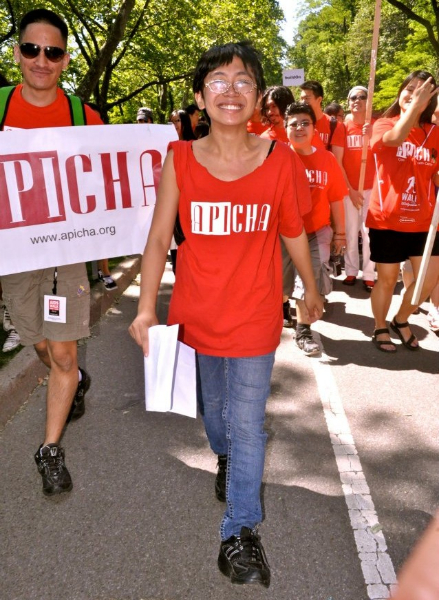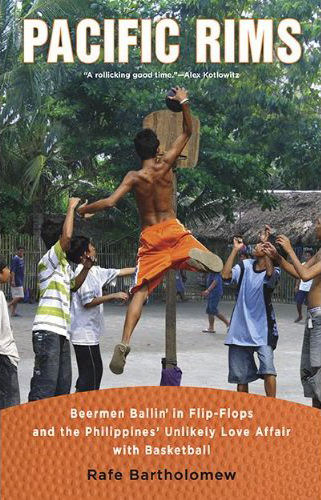How basketball defines the essence of being Filipino
By Daniel de la Rosa
He was supposed to stay in the Philippines for only one year, but New Yorker Rafe Bartholomew wound up going for three. That sounds like a line from a basketball game. Why go for a point on the free throw line when you could chuck it up for 3 points 25 feet away in the cheap seats.
Bartholomew’s book “Pacific Rims” is an enticing and enthralling account of a hoop crazy Fulbright scholar’s attempt to fathom why Filipinos are so nutty about a game involving putting a ball through a 10-foot high ring more often than the other side can.
He played pick-up games all over the Philippines, took part as a ringer in a basketball tournament in Boracay where he flashed the refs protesting a heated game, peered at Ferdinand Marcos’s mummified remains before finding a basketball court in the mountains of Ilocos Norte in a town called Adams (pop: 1,500 plus), was up close with the Alaska Aces in the PBA, and in the process, gave us a glimpse why Pinoys are the way we are.
He also earned the nickname Paeng from his friends on the Alaska team. Better than being called Rafist, which sounds too much like a perv on one of those “Law and Order SVU” episodes. ‘Hey Joe!’ became so familiar to him during games at Loyola Heights in the Ateneo campus in Quezon City.
At one point, his family name got chopped down to Bartolome at a tournament in Boracay because Bartholomew proved too long for a basketball T-shirt. Or maybe the team owner thought he could save money by dropping two letters.
Bartholomew did not gloss over the contradictions and venal political culture of the country. He went over the nearly inhumane treatment of American imports playing in the PBA. At one point, an import who was leading the league in scoring got dumped before the playoffs because Red Bull coach Yeng Guiao (who Rafe said seemed to scowl like a Mafia don on the court) did not feel he could win the championship with the guy. Guiao was right and Red Bull won the championship. The tactic was ruthless, but it won a ring. And who would not recognize that ferocity in the late George Steinbrenner of the New York Yankees?
The one good thing about the PBA for the imports is that the teams pay on time, which is not the case in other international arenas where the owners are known to skip out on paying their players.
Bartholomew also wondered why it was so much easier for the government to build a basketball court than to provide for better health and education for poor Filipinos. He also noted though that those ubiquitous courts in every town in the country served double duty as places where you could dry the rice crop, hold beauty pageants and became the social nerve center of most towns up and down the archipelago.
It was utterly fascinating watching him compare how during breaks, homegrown Pinoy basketball players would grab and pinch one another while sitting in a team lounge, while the FilAm cagers would keep a sliver of space among themselves – his cultural examination of attitudes of homoeroticism played out in a seemingly unconscious manner.
But underlying it all is a love of hoops that defies explanation.
He traced the roots of the game’s popularity from the time the 1936 Philippine squad played in the Berlin Olympics where it lost only one game but finished 5th and how it gave the best performance by a Philippine quintet at the World Basketball Championship in 1954. That team won 3rd behind the U.S. and Brazil. Caloy Loyzaga, still considered the best Filipino ballplayer of all time, was in that team.
That was the high-water mark of Pinoy basketball. But as the Philippines would win Asian championships here and there, it would never shine in international competitions like the Olympics. As the game spread and international stars reached the NBA, the best known Asian baller today is Yao Ming from China. No Pinoy player is even considered close to being an NBA prospect.
Despite that, the game remains unshakeable in its dominance of Philippine sports.
And for the first time in a long, long while, a Tagalog-speaking New Yorker comes along and gets why Filipinos love basketball even if the game does not love them back because it is a sport where height is king and we are kind of “short” in that department.
He provided the best explanation why basketball has such a grip on the psyche of Filipinos. “People have always struggled to define their essence, their soul, or whatever one wishes to call it. For Filipinos, basketball is part of that evanescent core.”
Maybe Filipino sports scribe Recah Trinidad put it best when he told Bartholomew: “How could you think of Filipino life without basketball? It’s not only a pastime, but a passion. There is no other game.”
In the end, “Pacific Rims” showed why Bartholomew fell in love with the country because he could see his own “irrational” love of hoops staring back at him amongst the millions of Filipinos he met and played with.
And he summed it up best as: “They came from disparate nooks of Philippine society; I came from thousands of miles away. Yet I understood their passion as well and as deeply as anything I’ve ever known, because the love for basketball that so many Filipinos felt was no different from my own; it was a love that anyone who ever scored a reverse layup in traffic, or stayed in front of a great ballhandler’s crossover, or threaded the needle on a pass, could understand.”
‘Pacific Rims: Beermen Ballin’ in Flip-Flops and the Philippines’ Unlikely Love Affair with Basketball’ published by NAL/ Penguin in June 2010 is available on Amazon.com.
Daniel de la Rosa is a freelance journalist who writes sports and business.












